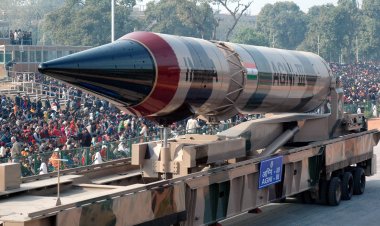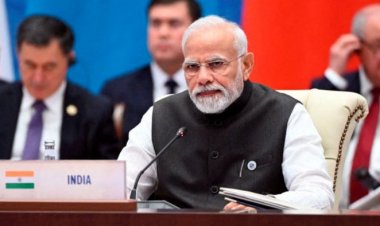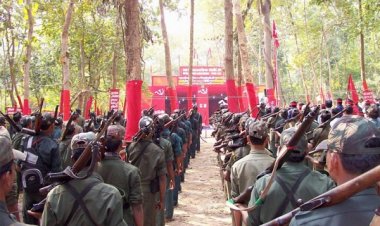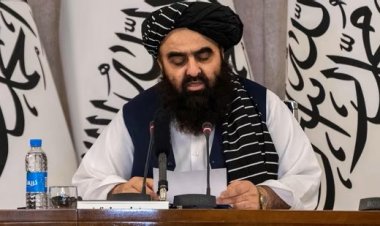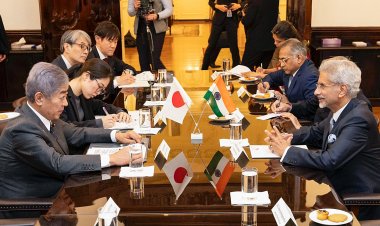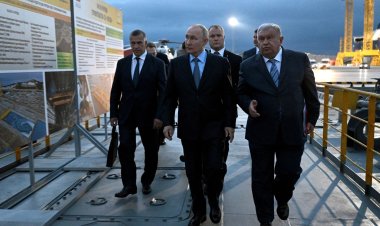China’s Latest Military Reorganization Terminates the PLA SSF & launches Three New Arm Forces based on it: Strategic implications of the PLA’s latest Reforms and Structural changes
This paper delves into the recent restructuring of the Chinese PLA. The PLA's latest reforms aim to restructure it for Multi-Domain Warfare by introducing three major changes to its system and layout.
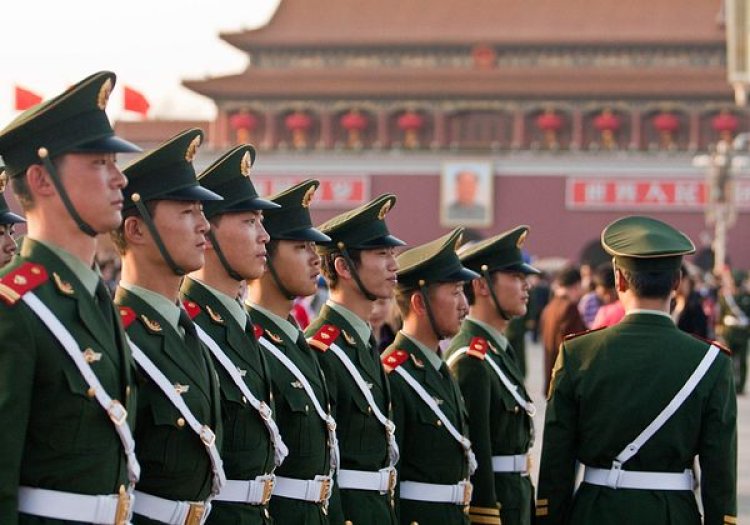
Analysis
Written By: Tenzin Younten
Edited By: Preeti Khenta `
On April 19, 2024, the Chinese government announced a comprehensive reorganization of the Chinese People's Liberation Army (PLA), marking the most significant restructuring since the 11th major PLA reorganization in 2015. The PLA's latest reforms aim to restructure it for Multi-Domain Warfare by introducing three major changes to its system and layout.
Central to this restructuring is a strategic overhaul of the PLA, which involves terminating the Chinese People's Liberation Army's fifth service branch, the Strategic Support Force (SSF). However, the SSF's functions are not dissipated; instead, its mission to win future wars is revamped and redistributed among the Information Support Force, Aerospace Force, and Cyberspace Force. This new arrangement operates under the PLA's new structure of four service branches and four independent arms.
The PLA's restructuring is a significant development that will have far-reaching implications for China's military capabilities and strategic posture. It reflects China's growing emphasis on modernizing its military and developing advanced capabilities in areas such as cyber and space warfare. The PLA's new structure will enable it to operate more effectively in a rapidly changing global security environment and enhance China's ability to project its power and influence beyond its borders.
This drastic reform elevates the role of the pre-existing China’s cyber, space, and information warfare forces previously housed within the Strategic Support Force, from a subordinate organization to a fully-fledged independent armed forces with enhanced capabilities, operational status, and resources.
Within this PLA’s reorganization, three key changes have been implemented, each bearing far-reaching implications for China and beyond includes:
- Introduction of China’s New Military System: featuring Four Military Service Branches and Four Independent Arms.
- Termination of the Chinese PLA Strategic Support Force and the subsequent formation of the Three New PLA Independent Arms.
- The Establishment of Three New Independent PLA Arms. Information Support Force, Cyber Force, and Military Aerospace Force.
Introduction of China’s New Military System: Featuring Four Military Service Branches and Four Independent Arms.
The previous structure and organization of the Chinese PLA comprised five Service branches, including the Ground Force, Navy, Air Force, Rocket Force, Strategic Support Force, and Joint Logistic Support Force. This organizational layout of PLA has undergone major changes, resulting in the establishment of a new system characterized by four service branches and four independent arms.
In essence, the reorganized PLA system now consists of four major service branches and four major independent arms. The four major service branches comprised of existing military branches of the PLA are
- PLA Army (陆军)
- PLA Navy (海军)
- PLA Air Force (空军)
- PLA Rocket Force (火箭军)
The four Independent Arms directly under the command of CMC, which included three new Arms and one existing Arm are
- PLA Military Aerospace Force (军事航天部队)
- PLA Information Support Force (信息支援部队)
- PLA Cyberspace Force (网络空间部队)
- PLA Joint Logistic Support Force (联勤保障部队)
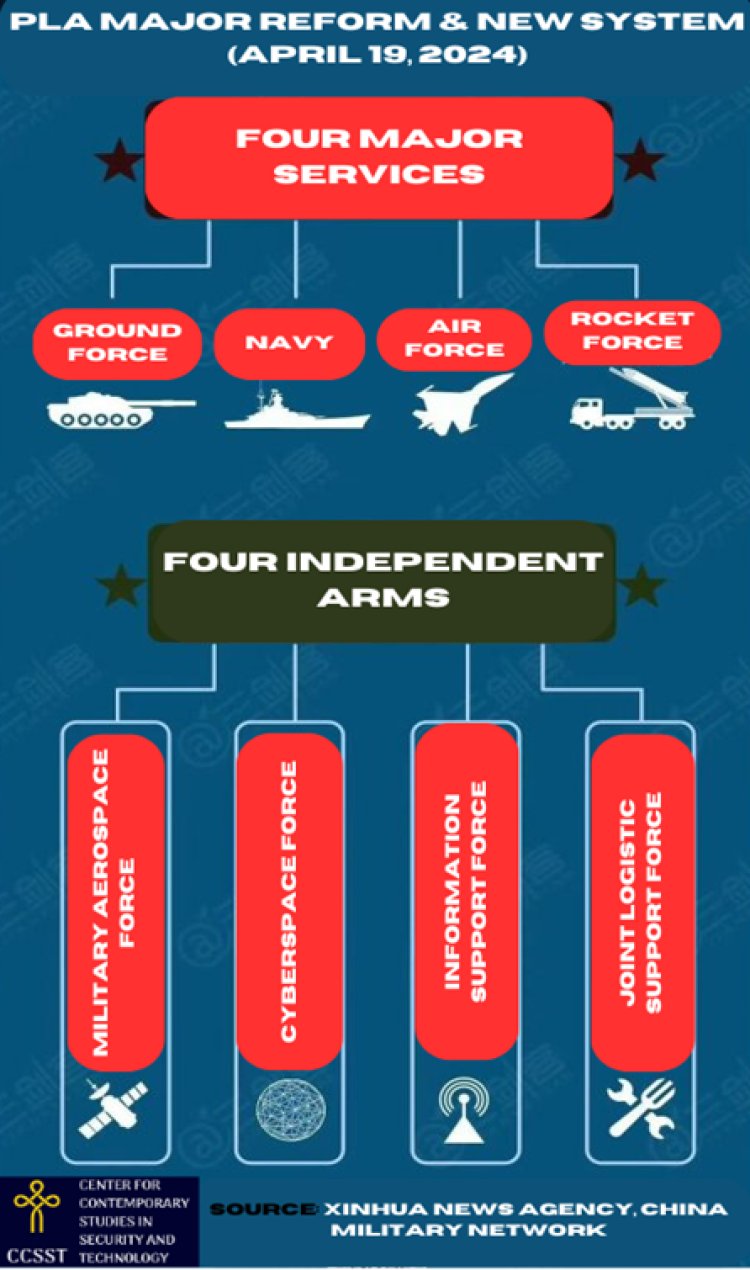
This latest PLA reorganization was officially unveiled during a special press conference organized by the Ministry of Defence (MOD) on the evening of Apr 19, 2024. Colonel Wu Qian, Spokesperson of the MOD, announced “With the latest reform, the PLA now has a new system of services and arms”
Termination of the Chinese PLA Strategic Support Force and the subsequent formation of the Three New PLA Independent Arms.
In the sweeping reforms, the refining of China’s modern military force structure culminated in the dissolution of China's shadowy military branch known as the PLA Strategic Support Force. Emerging from this terminated former Strategic Support Force are three new PLA specialized Arms Forces-Cyberspace, Information Support, and Military Aerospace- which now operate as Independent arms within the PLA’s new structure.
The establishment of the four Independent PLA Arms on April 19th, 2024 was composed of the preexisted Joint Logistic Support Force and the newly formed three Independent Arms based on SSF. With the unveiling of three new PLA Arms, China’s Strategic Support Force was established in December 2015. was dissolved in April 2024, lasting for a short period of 8 years.
The termination of SSF prompts major speculation regarding its implications, given its critical role in spearheading China’s modern warfare capabilities, especially in Electronic, Cyber, and Space Warfare. Since its inception in 2015, SSF has been tasked with critical military and strategic operations, ranging from information & logistic support, network operations, space support, lighting, and electromagnetic interference, and military transportation to equipment maintenance support.
The Establishment of Three New Independent PLA Arms.Information Support Force, Cyber Force, and Military Aerospace Force.
Following the dissolution of the SSF, it is likely that its department(subordinates) was reorganized and divided to establish three new Independent PLA Arms Notably, the role of the sub-organizations previously under the Strategic Support Forces including the Network System Department, Space System Department, and various units under the Information Communication Bureaus are likely promoted to form three new independent PLA Arms, now operating directly under the Central Military Commission (CMC).
|
S.No |
SSF’s Sub-organization |
Operations |
Newly Formed Independent Arms |
|
1. |
Network System Department (NSD) |
Cyber warfare, electronic warfare, psychological warfare, and technical reconnaissance |
Cyberspace Force |
|
2. |
Space System Department |
PLA space operations, including space launch and support; telemetry, tracking, and control; information support, space warfare, rapid development of aerospace technology & weapons. |
Military Aerospace Force |
|
3. |
Information and Communications Bureau |
Informational Warfare |
Information Support Force |
Source: Collated and translated by the author.
The formation of three new PLA Arms, alongside the existing Joint Logistic Support Force was introduced as part of the newly reformed PLA structure and System on April 19, 2024.
The PLA’s Cyberspace Force primarily built around the Network System Department (NSD) from the dissolved SSF, will reinforce China’s capabilities in cyber warfare, electronic warfare, psychological warfare, and technical reconnaissance. The Military Aerospace Force created from the former Space System Departments (SSD) of the SSF, will oversee PLA space operations, including space launch and support; telemetry, tracking, and control; information support; and space warfare. Simultaneously, the third newly formed Independent Arm known as the Information Support Force is likely to be formed from the Information and Communications Bureau, spearheading China’s information warfare operations. The three independent arms likely incorporate these elements from the Strategic Support Force but they are expected to incorporate new specialized organizations or departments under it. While the leadership of the Information Support Force was announced during its founding meeting on April 19, 2024. However, the official commanders and the political commissars of the Cyber and Space Force are yet to be announced.
Conclusion
One primary reason behind the PLA’s latest reform may stem from the expansive scope of operations and responsibilities undertaken by the Strategic Support Force (SSF). The elevation of the former SSF department’s role to establish the three new arms underscores China’s strategic objective to bolster multi-domain military capabilities encompassing electronic, cyber, and space warfare, concurrently with combat support operations.
In short, PLA’s latest reforms signify a major step towards the realization of modernizing its military by 2035 through integrated development of mechanization, informatization, and intelligence, ultimately aiming to build a world-class army by 2050.
Before the reform, the PLA SSF had been integral to conducting China’s Grey zone operations, particularly in information warfare across the globe. Under SSF, China employs tactics such as malicious cyber attacks, espionage, economic war, political warfare, and physical intrusions against the United States, Taiwan, India, Asian countries, and other adversaries worldwide. The gravity of cyber threats from China prompted the U.S. Department of Defense to acknowledge China as the most significant cybersecurity threat to the United States in 2023. Furthermore, the FBI director’s warning in April 2024 highlighted that “Chinese government-linked hackers have burrowed into U.S. critical infrastructure and are waiting "for just the right moment to deal a devastating blow," A Pentagon report in 2022, reported China’s Intelligence, surveillance and reconnaissance (ISR) satellite fleet comprising of over 290 systems, previously probably under Network System Department of SSF are capable of monitoring, tracking and targeting U.S. and allied forces worldwide, especially across the Indo-Pacific Region, posing critical security challenges.
Moreover, along the western frontiers of Occupied Tibet, China continues to wage an information war under its Grey zone operations against India. The renaming and cartographically claiming Indian Sovereign territories of Arunachal Pradesh, exemplify its latest employment of “Three Warfare”, comprising public opinion, psychological and legal warfare, as part of China’s broader information and intelligence warfare.
As China continues to expand space, cyber, electromagnetic, and psychological warfare capabilities through recent military reforms, it presents new challenges and potential threats to security and stability in the Asian region and beyond.
Disclaimer: This paper is the author's individual scholastic contribution and does not necessarily reflect the organization's viewpoint.
Tenzin Younten is a strategic and Sino-centric researcher and an OSINT practitioner specializing in Chinese Military, Tibetan Studies, and Human Rights violations. He has worked as a Research Analyst for Pincaca Technology Pvt., Ltd for the past two years and as an Associate Researcher at the Center for Contemporary Studies in Security and Technology (CCSST). Previously worked under the Central Tibetan Administration (CTA) in different agencies including the Tibet Policy Institute and Department for Information and International Relations and also in the Indic Researchers Forum as a research intern.

